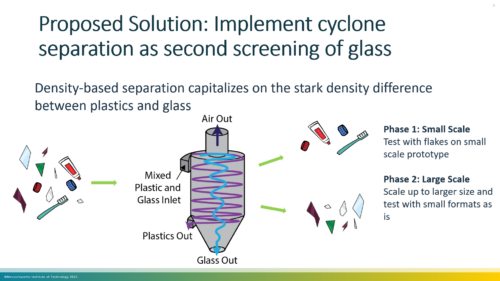Menu
ESI Stories
Cyclone-Like Technology Holds Promise in Creating a Circular Economy for Small Plastics
By: Sophia Apteker, Administrative and Communications Assistant
For Alexis Hocken, a third-year PhD student in the Department of Chemical Engineering at MIT, conversations at the Packaging Recycling Summit revolved around a singular question: How can people — at all links of the circular supply chain — bridge the communicative gap between brands who are designing plastic packaging and material recovery facilities (MRFs) that are recycling them?
Hocken works specifically with small-format plastics, or items that are less than two inches long in at least two dimensions. (Think: travel-sized containers, cosmetic packaging, or other consumer product goods.) When it comes to her research, the disconnect occurs when these products are sent to a MRF to be recycled, but their tiny size causes them to slip through a mesh screen, which was intended to filter out glass shards.
“It results in this glass stream that’s riddled with a lot of these valuable small formats that could be recycled and ultimately are not getting recycled,” Hocken said.

At a typical MRF, small-format plastics slip through a mesh glass breaker screen early on in the recycling process. Photo courtesy of Alexis Hocken
To get these plastics to the end of the recycling line, a coalition of consumer product companies — including Colgate-Palmolive, Procter & Gamble, the Estée Lauder Companies, L’Oreal, and Haleon — have partnered with Hocken and her team in Prof. Brad Olsen’s lab to develop solutions. The lab also works in collaboration with Desirée Plata, an associate professor of civil and environmental engineering; the MIT Environmental Solutions Initiative; and The Sustainability Consortium.
At the Summit, Hocken spoke on a panel titled “Making the Case for Small-Format Packaging Recycling.” She was joined by Jennifer Park, the Director of Engagement at The Sustainability Consortium, and Ana Espinosa, the Packaging Sustainability Manager at ELC Management llc. Approximately 300 people were in attendance, either in person or virtually.
Park opened with a few notes on why eliminating small-format plastics, or just making them bigger, is not a sustainable solution. Most importantly, many small plastics are small for a reason: they maintain the utility of the object. (“You wouldn’t want, or be able to use, a giant Chapstick tube or contact lens case,” she said.) This presents a problem to a slew of companies, specifically those within the cosmetics industry, that have portfolios dominated by small-format plastics.
Because if the plastics’ size can’t be altered, then what?
Espinosa pointed to innovation within the current recycling streams and processes, a space where Hocken was able to step in. She presented her lab’s proposed solution: a secondary cyclone-like screening process.
“It’s like a density-based separation where we can capitalize on the stark density differential between plastic and glass,” Hocken said of the technology. “It results in these two theoretically pure streams: one glass and one of small format plastics. These plastics can then be recovered and used in new products and packaging.”

A secondary screen would be able to separate the plastic and glass that fell through the glass breaker screen. Photo courtesy of Alexis Hocken
“So we have this mixed plastic and glass inlet that’s fed through into this cyclone,” Hocken said in her presentation. “Basically, you have this circular air profile that’s present, and so your lighter plastics will be able to stay suspended within this air profile long enough to be able to access out this side outlet. Whereas your glass, this denser, heavier material, would be relatively unaffected by this air profile and just fall out the bottom.”
Since there isn’t a lot of data available on the amount of these small format plastics that are actually making it into these recovery facilities, The Summit was useful in connecting those working on this project, especially within The Sustainability Consortium, to industry leaders with resources that could assist them in furthering their research. The conference also helped garner a more well-rounded perspective regarding the cyclone’s feasibility, especially from those at MRFs.
Looking ahead, the cyclone’s results are promising. Hocken and her team ran a techno-economic assessment (TEA) and calculated its global warming potential (GWP) to determine if its implementation would be beneficial from economic and environmental standpoints. The cyclone checked both boxes.
Recently, the team has filed a patent with the MIT Technology Licensing Office.
“We’ve seen really effective separations already within this smaller prototype,” Hocken said. “We’re excited to keep digging and keep pushing this technology to be more similar to what you would see in a realistic environment, that is, a waste recovery facility, and see how it performs in those more challenging or intense circumstances.”
To view the full presentation and slides, you can make a free account on the Packaging World website.















